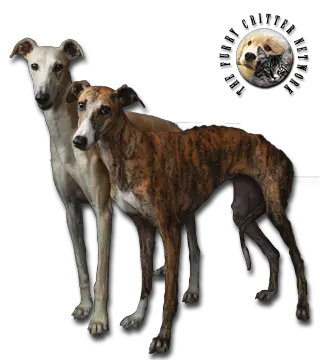Breed Standard
Head: Long, narrow, cleanly cut. Skull not very broad, subconvex. Very slight stop. Slightly curved nosebridge. Long, narrow muzzle. Very tight-lipped. Small, black nose.
Ears: Set on high, wide at the base, triangular, with rounded tips. Rose-shaped and lying flat against the head at rest.
Eyes: Small, almond-shaped, slanted. Dark hazel. Dark eyelids.
Body: Strong, slightly rectangular build. Neck long, strong, oval in cross-section. Chest not very broad but ample. Ribs highly visible. Long, strong, arched loin. Pronounced tuck-up (high-standing). Straight, long back. Long, powerful, arched croup.
Tail: Set on low, very long, flexible, thick at the base and tapering toward the tip. At rest, hanging in sickle fashion with an inward-curving hook at the tip.
Hair: Short, very fine, smooth, dense. Slightly longer on the backs of the thighs. In the wirehaired variety, medium in length and forming a light beard, mustache, eyebrows, and topknot.
Coat: All colors are allowed. The most typical, in order of preference, are a shade of well-pigmented fawn and brindle. Black. Spotted black, dark and light. Burnt chestnut. Cinnamon. Yellow. Red. White.
Size: Dog: 62 to 70 cm. (24.5-27.5 in).Bitch: 60 to 68 cm. (23.5-27 in).
Weight: Dog: 25 to 30 kg. (55-66 lb).Bitch: 20 to 25 kg. (44-55 lb).
History
This sighthound was kept by the Romans in ancient times but brought to Spain even earlier. Some believe the Spanish Greyhound (galgo means "greyhound" in Spanish) might be descended from the Arabian Greyhound, introduced to Spain by the Moors in the ninth century. The Spanish Greyhound was prized by Spanish nobility and used primarily in racing. In order to obtain faster dogs, many crosses were made with the Greyhound, creating an English-Spanish variety. Many Spanish Greyhounds were exported to Ireland and England, in particular, during the sixteenth, seventeenth, and eighteenth centuries. Still commonly used by Spanish hunters.
Behavior
The tough, active, very hardy Spanish Greyhound specializes in hare but also hunts fox and wild boar. He has a rather mediocre nose. Gentle and very attached to his owner, he is the most affectionate and demonstrative of all the sighthounds. He needs gentle training.
He cannot live in an apartment and does not like being confined. He needs lots of exercise, including frequent runs. He must be brushed regularly.
Function
Hunting Dog, Companion Dog.
Health
Like many other sighthounds, Galgos are a fairly healthy breed although they are sensitive to anaesthesia. As such, proper care should be taken by the owner to ensure that the attending veterinarian is aware of this issue. Although Galgos are big dogs, their history of selection as a working sighthound, their light weight, and their anatomy keep them safe from hip dysplasia. These dogs must run regularly to keep in perfect health, combined with their characteristic tendency to sleep all the rest of the day.






